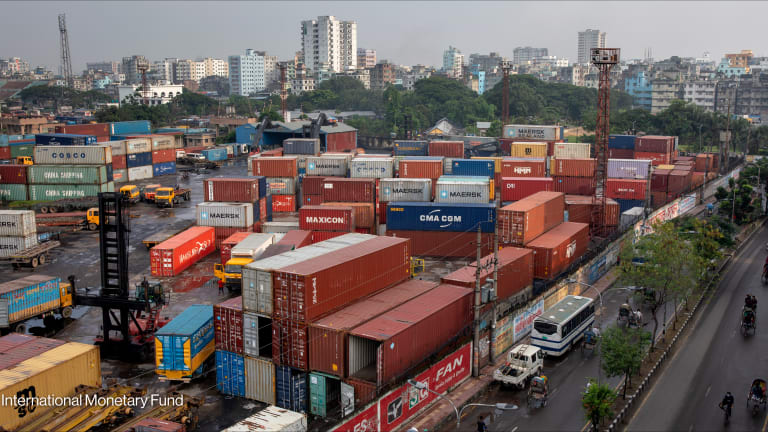Afghanistan's top aid donors and how much was spent for gender equality
Afghanistan has received some $50 billion in official development assistance across 10 years. Who were the major donors and how much has been spent for gender equality since 2010?
Aid organizations face much uncertainty surrounding the future of their work in Afghanistan under the new Taliban regime. Questions range from whether they will stay and continue programs — some of which have a strong focus on gender — to what the future of development funding will look like. Afghanistan was the fourth-largest recipient of official development assistance in 2019 after Syria, Ethiopia, and Bangladesh. It received $4.1 billion — a 13% increase over 2018. From 2010 to 2019, the country received a total of about $50 billion in official development assistance from development donors — including the Development Assistance Committee, multilaterals, and non-DAC countries. In this article, Devex takes a deep dive into the Organisation for Economic Co-operation and Development’s historical data to unveil the top development aid donors to the country over the last 10 years. We also looked at how much the donors spent on gender equality and women’s empowerment — a key sector of concern, given that the country’s new rulers have a history of imposing strict rules on women. While OECD’s gender policy marker is known to have shortcomings, it is one of the only available tools to grasp how much funding has been directed toward gender equality. In this analysis, we focus solely on the funding for which gender equality is the “principal” objective of the project and would not have been undertaken otherwise. Overall, the top 10 donors accounted for 86% of the total aid received by Afghanistan across the period, with the United States alone representing 42% of the total funding. <div class="flourish-embed flourish-bar-chart-race" data-src="visualisation/7029912"><script src="https://public.flourish.studio/resources/embed.js"></script></div> Afghanistan’s top 10 development aid donors from 2010 to 2019. Top development aid donors in Afghanistan 2010-2019 1. United States Total aid: $20.9 billion Highest aid disbursement: $3.6 billion in 2010 Total principal gender spending: $459 million The U.S. is the top donor to Afghanistan, disbursing more than four times as much ODA as the second donor across the period analyzed. U.S. funding saw an overall decrease of 61% — from $3.6 billion in 2010 to $1.4 billion in 2019. The United States Agency for International Development and the State Department are the primary agencies funding gender-focused aid projects, which represent 2% of total U.S. spending. 2. Germany Total aid: $4.7 billion Highest aid disbursement: $536 million in 2016 Total principal gender spending: $136 million While the data shows that funding decreased by 11% from 2010 to 2019 — from $460 million funding to $409 million — there were six years where German’s ODA to Afghanistan surpassed 2010’s levels. While Germany is the second-largest donor to Afghanistan in overall ODA trends, it ranks fourth in absolute figures in principal gender equality funding. Three percent of the total aid was directed toward gender equality outcomes. The Federal Ministry for Economic Cooperation and Development, or BMZ, was responsible for 75% of gender equality funding, followed by the Foreign Office, which managed 22% of those funds. 3. Japan Total aid: $4.1 billion Highest aid disbursement: $672 million in 2013 Total principal gender spending: $368 million Japanese aid funding plummeted by nearly 80%, from $610 million in 2010 to $131 million in 2019. The biggest fall was seen during 2013 to 2014, when aid levels fell by 42%. Since then, they have fallen 50% more. While the Japan International Cooperation Agency is Japan’s main development agency, the Foreign Affairs Ministry managed almost 99% of the gender-focused programs across the period — which represented 9% of Japan’s total aid spending in Afghanistan. 4. United Kingdom Total aid: $3.4 billion Highest aid disbursement: $416 million in 2015 Total principal gender spending: $20 million In the span of almost 10 years, U.K. funding to Afghanistan grew to 75%, seeing as the $231 million in 2010 was the lowest level of aid across this period. The Department for International Development, and the Foreign and Commonwealth Office — which merged and is now the Foreign, Commonwealth & Development Office — channeled $19 million to gender-focused programs, which represents only 0.5% of the U.K.’s total aid to the country. In absolute terms, the U.K. ranks 11th in supporting gender equality development programs in Afghanistan. 5. EU Institutions Total aid: $3.3 billion Highest aid disbursement: $444 million in 2018 Total principal gender spending: $6.4 million From 2010 to 2019, EU institutions such as the European Commission, increased their funding to Afghanistan by 55%. While there was a 6% decrease from 2018 to 2019, EU institutions were second to the U.S. in terms of aid volume throughout both years. They were, however, ranking 16th in gender-focused aid programs — spending only 0.2% of total funding. 6. International Development Assistance (World Bank) Total aid: $1.8 billion Highest aid disbursement: $379.9 million in 2019 Total principal gender spending: No data While the World Bank started out providing $139 million in overall aid to Afghanistan in 2010, it reached its lowest funding disbursement at $85.1 million by 2016. But since then, its funding has steadily increased. Overall, its funding experienced a 174.3% increase in 2019 compared to 2010. In 2018 and 2019, it ranked as the fourth development donor to the country. There is no data on its spending on gender equality programs. 7. Asian Development Bank Total aid for: $1.8 billion Highest aid disbursement: $231.9 million in 2010 Total principal gender spending: No data ADB’s aid decreased by 12.2% in 2019 compared to 2010, with the same total spending volume as the World Bank throughout the period. Its lowest funding level was in 2014 — at $99.3 million. There is no data on its disbursement for gender equality programs. 8. Canada Total aid: $1.3 billion Highest aid disbursement: $238.6 million in 2010 Total principal gender spending: $96.1 million Canada’s total aid decreased by 50.9% across the period, since 2010 was the year with the highest disbursement. The lowest was at $69.5 million in 2017. Spending 7% of the total in gender-focused programs makes Canada the fifth-top donor for gender equality in Afghanistan. 9. Sweden Total aid: $1.1 billion Highest aid disbursement: $138.1 million in 2018 Total principal gender spending: $393 million Sweden saw a 69.1% increase in total aid between 2010 and 2019. It was the second-largest donor focusing on gender-focused programs, with 35% of its aid spending targeting gender equality outcomes. 10. Australia Total aid: $919 million Highest aid disbursement: $169.8 million in 2012 Total principal gender spending: $67.2 million Overall, Australian aid recorded a 30.3% decrease in funding between 2010 and 2019, with the lowest level in 2017 at $58.2 million — close to the $61 million it spent in 2019. It ranks sixth in terms of gender equality spending, having disbursed 7% of its total aid toward those outcomes. Try out Devex Pro Funding today with a free 5-day trial, and explore funding opportunities from over 850+ sources in addition to our analysis and news content.
Aid organizations face much uncertainty surrounding the future of their work in Afghanistan under the new Taliban regime. Questions range from whether they will stay and continue programs — some of which have a strong focus on gender — to what the future of development funding will look like.
Afghanistan was the fourth-largest recipient of official development assistance in 2019 after Syria, Ethiopia, and Bangladesh. It received $4.1 billion — a 13% increase over 2018. From 2010 to 2019, the country received a total of about $50 billion in official development assistance from development donors — including the Development Assistance Committee, multilaterals, and non-DAC countries.
In this article, Devex takes a deep dive into the Organisation for Economic Co-operation and Development’s historical data to unveil the top development aid donors to the country over the last 10 years. We also looked at how much the donors spent on gender equality and women’s empowerment — a key sector of concern, given that the country’s new rulers have a history of imposing strict rules on women.
This story is forDevex Promembers
Unlock this story now with a 15-day free trial of Devex Pro.
With a Devex Pro subscription you'll get access to deeper analysis and exclusive insights from our reporters and analysts.
Start my free trialRequest a group subscription Printing articles to share with others is a breach of our terms and conditions and copyright policy. Please use the sharing options on the left side of the article. Devex Pro members may share up to 10 articles per month using the Pro share tool ( ).
Janadale Leene Coralde works as a contributing analyst for Devex. Based in Manila she reports on development donors activities and designs funding data visualisations. She has a degree in political economy, specializing in international relations and development, and has previously worked as a researcher for Chemonics, the REID foundation, and the Philippines House of Representatives.
Raquel Alcega leads the data research and analysis at Devex, providing advice to organizations on the latest funding and programmatic trends that shape the global development space. She also heads up the news business content strategy and designs internal knowledge management processes. Prior to joining Devex’s Barcelona office, she worked in business development in Washington, D.C., and as a researcher in Russia and Mexico.









